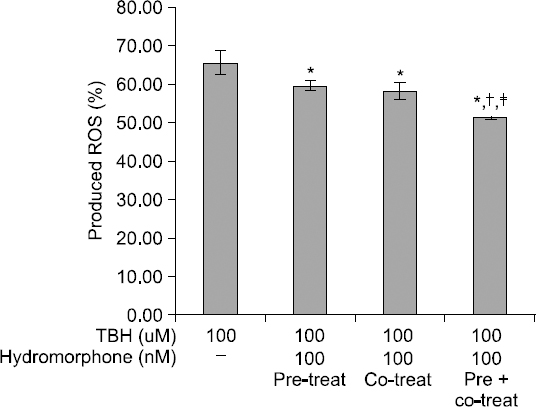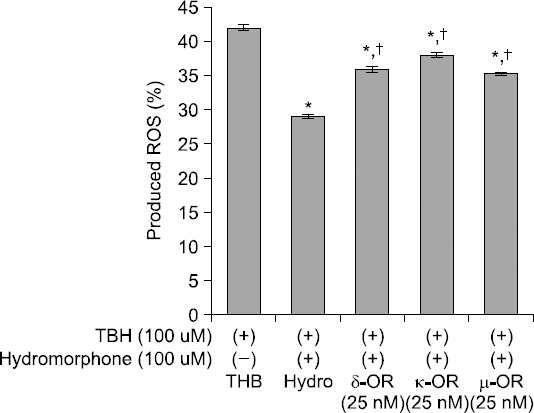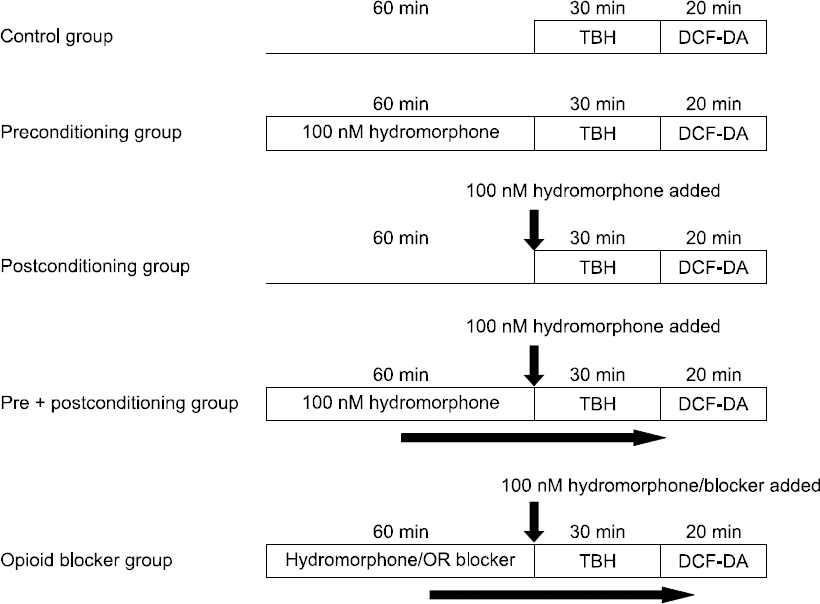1. Vicente E, Degerone D, Bohn L, Scornavaca F, Pimentel A, Leite MC, et al. Astroglial and cognitive effects of chronic cerebral hypoperfusion in the rat. Brain Res. 2009; 1251:204–12. DOI:
10.1016/j.brainres.2008.11.032. PMID:
19056357.

2. Bilotta F, Gelb AW, Stazi E, Titi L, Paoloni FP, Rosa G. Pharmacological perioperative brain neuroprotection: a qualitative review of randomized clinical trials. Br J Anaesth. 2013; 110(Suppl 1):i113–20. DOI:
10.1093/bja/aet059. PMID:
23562933.

3. Gross GJ, Baker JE, Hsu A, Wu HE, Falck JR, Nithipatikom K. Evidence for a role of opioids in epoxyeicosatrienoic acid-induced cardioprotection in rat hearts. Am J Physiol Heart Circ Physiol. 2010; 298:H2201–7. DOI:
10.1152/ajpheart.00815.2009. PMID:
20400686. PMCID:
PMC2886625.

4. Goldsmith JR, Perez-Chanona E, Yadav PN, Whistler J, Roth B, Jobin C. Intestinal epithelial cell-derived mu-opioid signaling protects against ischemia reperfusion injury through PI3K signaling. Am J Pathol. 2013; 182:776–85. DOI:
10.1016/j.ajpath.2012.11.021. PMID:
23291213. PMCID:
PMC3589074.
5. Gwak MS, Li L, Zuo Z. Morphine preconditioning reduces lipopolysaccharide and interferon-gamma-induced mouse microglial cell injury via delta 1 opioid receptor activation. Neuroscience. 2010; 167:256–60. DOI:
10.1016/j.neuroscience.2010.02.017. PMID:
20156527. PMCID:
PMC2849923.
6. Teo JD, Morris MJ, Jones NM. Hypoxic postconditioning reduces microglial activation, astrocyte and caspase activity, and inflammatory markers after hypoxia-ischemia in the neonatal rat brain. Pediatr Res. 2015; 77:757–64. DOI:
10.1038/pr.2015.47. PMID:
25751571.

7. Scheufler KM, Zentner J. Total intravenous anesthesia for intraoperative monitoring of the motor pathways: an integral view combining clinical and experimental data. J Neurosurg. 2002; 96:571–9. DOI:
10.3171/jns.2002.96.3.0571. PMID:
11883843.

8. Kim EM, Park WY, Choi EM, Choi SH, Min KT. A retrospective analysis of prolonged propofol- remifentanil anesthesia in the neurosurgical patients. Anesth Pain Med. 2008; 3:288–92.
9. Zhang Y, Irwin MG, Lu Y, Mei B, Zuo YM, Chen ZW, et al. Intracerebroventricular administration of morphine confers remote cardioprotection role of opioid receptors and calmodulin. Eur J Pharmacol. 2011; 656:74–80. DOI:
10.1016/j.ejphar.2011.01.027. PMID:
21291882.
10. Rostami F, Oryan S, Ahmadiani A, Dargahi L. Morphine preconditioning protects against LPS-induced neuroinflammation and memory deficit. J Mol Neurosci. 2012; 48:22–34. DOI:
10.1007/s12031-012-9726-4. PMID:
22388653.

11. Iwata-Ichikawa E, Kondo Y, Miyazaki I, Asanuma M, Ogawa N. Glial cells protect neurons against oxidative stress via transcriptional up-regulation of the glutathione synthesis. J Neurochem. 1999; 72:2334–44. DOI:
10.1046/j.1471-4159.1999.0722334.x. PMID:
10349842.

12. Kreutzberg GW. Microglia: a sensor for pathological events in the CNS. Trends Neurosci. 1996; 19:312–8. DOI:
10.1016/0166-2236(96)10049-7.

13. Brown GC, Bal-Price A. Inflammatory neurodegeneration mediated by nitric oxide, glutamate, and mitochondria. Mol Neurobiol. 2003; 27:325–55. DOI:
10.1385/MN:27:3:325.

14. Hu Y, Wang S, Wang A, Lin L, Chen M, Wang Y. Antioxidant and hepatoprotective effect of Penthorum chinense Pursh extract against t-BHP-induced liver damage in L02 cells. Molecules. 2015; 20:6443–53. DOI:
10.3390/molecules20046443. PMID:
25867829.

16. Milisav I, Poljsak B, Suput D. Adaptive response, evidence of cross-resistance and its potential clinical use. Int J Mol Sci. 2012; 13:10771–806. DOI:
10.3390/ijms130910771. PMID:
23109822. PMCID:
PMC3472714.

17. Das M, Das DK. Molecular mechanism of preconditioning. IUBMB Life. 2008; 60:199–203. DOI:
10.1002/iub.31. PMID:
18344203.

18. Rush GF, Gorski JR, Ripple MG, Sowinski J, Bugelski P, Hewitt WR. Organic hydroperoxide-induced lipid peroxidation and cell death in isolated hepatocytes. Toxicol Appl Pharmacol. 1985; 78:473–83. DOI:
10.1016/0041-008X(85)90255-8.

19. Holownia A, Mroz RM, Wielgat P, Skiepko A, Sitko E, Jakubow P, et al. Propofol protects rat astroglial cells against tert-butyl hydroperoxide-induced cytotoxicity;the effect on histone and cAMP-response-element-binding protein (CREB) signalling. J Physiol Pharmacol. 2009; 60:63–9. PMID:
20065498.
20. Hutchinson MR, Bland ST, Johnson KW, Rice KC, Maier SF, Watkins LR. Opioid-induced glial activation: mechanisms of activation and implications for opioid analgesia, dependence, and reward. ScientificWorldJournal. 2007; 7:98–111. DOI:
10.1100/tsw.2007.230. PMID:
17982582.

21. Madera-Salcedo IK, Cruz SL, Gonzalez-Espinosa C. Morphine decreases early peritoneal innate immunity responses in Swiss- Webster and C57BL6/J mice through the inhibition of mast cell TNF-alpha release. J Neuroimmunol. 2011; 232:101–7. DOI:
10.1016/j.jneuroim.2010.10.017. PMID:
21087796.
22. Askari N, Mahboudi F, Haeri-Rohani A, Kazemi B, Sarrami R, Edalat R, et al. Effects of single administration of morphine on G-protein mRNA level in the presence and absence of inflammation in the rat spinal cord. Scand J Immunol. 2008; 67:47–52. DOI:
10.1111/j.1365-3083.2007.02043.x. PMID:
18052964.

23. Watkins LR, Hutchinson MR, Rice KC, Maier SF. The “toll” of opioid-induced glial activation: improving the clinical efficacy of opioids by targeting glia. Trends Pharmacol Sci. 2009; 30:581–91. DOI:
10.1016/j.tips.2009.08.002. PMID:
19762094. PMCID:
PMC2783351.

24. Ricket A, Mateyoke G, Vallabh M, Owen C, Peppin J. A pilot evaluation of a hydromorphone dose substitution policy and the effects on patient safety and pain management. J Pain Palliat Care Pharmacother. 2015; 29:120–4. DOI:
10.3109/15360288.2015.1035829. PMID:
26095481.

25. Oosten AW, Oldenmenger WH, Mathijssen RH, van der Rijt CC. A systematic review of prospective studies reporting adverse events of commonly used opioids for cancer-related pain: a call for the use of standardized outcome measures. J Pain. 2015; 16:935–46. DOI:
10.1016/j.jpain.2015.05.006. PMID:
26051219.

26. Wirz S, Wartenberg HC, Nadstawek J. Less nausea, emesis, and constipation comparing hydromorphone and morphine? A prospective open-labeled investigation on cancer pain. Support Care Cancer. 2008; 16:999–1009. DOI:
10.1007/s00520-007-0368-y. PMID:
18095008.

27. Guedes AG, Papich MG, Rude EP, Rider MA. Comparison of plasma histamine levels after intravenous administration of hydromorphone and morphine in dogs. J Vet Pharmacol Ther. 2007; 30:516–22. DOI:
10.1111/j.1365-2885.2007.00911.x. PMID:
17991219.

28. Wolf NB, Kuchler S, Radowski MR, Blaschke T, Kramer KD, Weindl G, et al. Influences of opioids and nanoparticles on in vitro wound healing models. Eur J Pharm Biopharm. 2009; 73:34–42. DOI:
10.1016/j.ejpb.2009.03.009. PMID:
19344759.

29. Wu S, Wong MC, Chen M, Cho CH, Wong TM. Role of opioid receptors in cardioprotection of cold-restraint stress and morphine. J Biomed Sci. 2004; 11:726–31. DOI:
10.1007/BF02254356. PMID:
15591768.

30. Jeong S, Kim SJ, Jeong C, Lee S, Jeong H, Lee J, et al. Neuroprotective effects of remifentanil against transient focal cerebral ischemia in rats. J Neurosurg Anesthesiol. 2012; 24:51–7. DOI:
10.1097/ANA.0b013e3182368d70. PMID:
22015431.







 PDF
PDF Citation
Citation Print
Print



 XML Download
XML Download